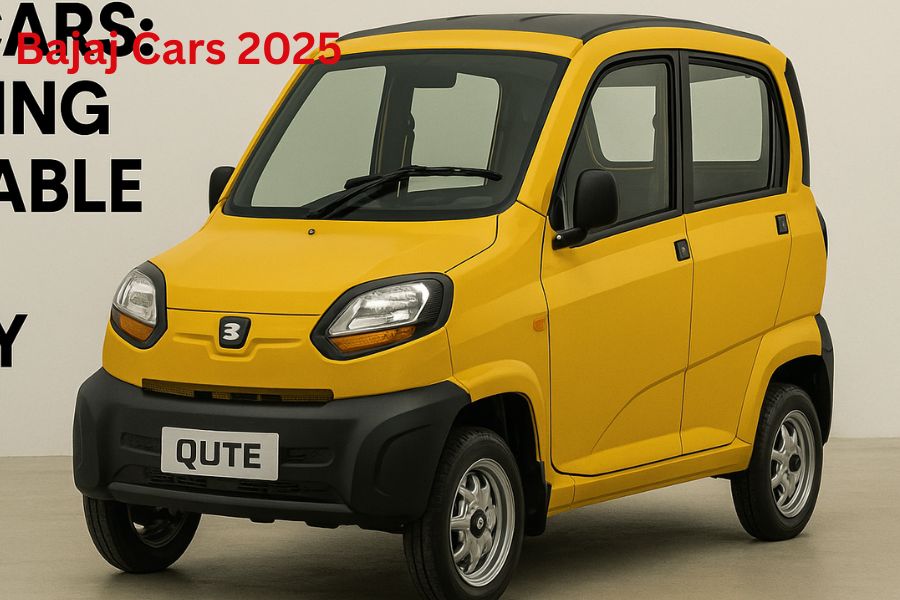Bajaj Cars 2025 : Revolutionizing Affordable Mobility in India
Bajaj Auto, a name synonymous with two-wheelers and three-wheelers in India, has also made a significant mark in the automobile industry through its compact and ultra-affordable car offerings. The company, known for its innovation and value-driven engineering, ventured into the car market with a bold vision to redefine personal mobility, especially for the middle-class and lower-income segments. Though Bajaj is not a mainstream car manufacturer like Maruti Suzuki or Hyundai, its unique approach to vehicle design and purpose makes it a standout player.
Bajaj Cars 2025 : The Genesis of Bajaj’s Entry into the Car Segment
Bajaj’s foray into the four-wheeler segment was inspired by its ambition to offer low-cost transportation that bridges the gap between two-wheelers and cars. This vision materialized in the form of the Bajaj Qute, a compact quadricycle that challenged the conventional ideas of urban transport. The Qute is not a full-fledged car by traditional standards, but rather a lightweight, fuel-efficient alternative designed for short-distance travel and city commutes. Bajaj introduced this vehicle with the intent to provide an economical, safe, and eco-friendly solution for families and commercial operators.
Bajaj Cars 2025: Qute India’s First Quadricycle
The Bajaj Qute is India’s first quadricycle and is officially approved for commercial and personal use in various states. It runs on a 216cc engine and offers a top speed of about 70 km/h. With a fuel efficiency of over 30 km/l, the Qute is an incredibly economical vehicle to operate. It comes in both petrol and CNG variants, making it ideal for users looking for low running costs. The design of the Qute emphasizes practicality, with its compact dimensions allowing easy navigation through crowded urban streets.
Bajaj Cars 2025:Target Market and Purpose
Unlike traditional passenger cars, the Qute is aimed at a niche market of auto-rickshaw drivers, small business owners, and urban dwellers who need basic transportation without the high cost of ownership. Bajaj identified a gap in the market where many people could not afford traditional cars but needed something safer and more stable than a two-wheeler or auto-rickshaw. The Qute fits perfectly into this space by offering car-like protection with motorcycle-level affordability.
Bajaj Cars 2025: Design Philosophy and Features
The Bajaj Qute’s design is minimalist yet functional. It offers seating for four, including the driver, and features basic interiors that prioritize utility over luxury. Despite its small size, it provides ample headroom and legroom for passengers, especially for short to medium commutes. Safety is modestly addressed with features like seat belts for all occupants and a reinforced body structure. While it may not come with high-end infotainment systems or power steering, its low cost and simple mechanics make it extremely easy and inexpensive to maintain
Bajaj faced several regulatory hurdles during the launch of the Qute. Since quadricycles were not previously categorized under India’s automobile regulations, the company had to work with government authorities to define standards for such vehicles. Additionally, public perception initially posed a challenge, as many consumers were unsure about whether to consider the Qute a car or a rickshaw upgrade. However, over time, especially with adoption in commercial segments like fleet operations and last-mile delivery, the Qute has carved out a growing market presence.B
Bajaj Cars 2025: Vision for the Future of Urban Mobility
Bajaj Auto’s strategy has always been centered around smart and affordable transportation. With the Qute, the company opened a new chapter in mobility by pushing the boundaries of conventional vehicle design. Looking ahead, Bajaj is expected to continue investing in lightweight, compact vehicles that meet the mobility needs of congested cities. With increasing focus on electric vehicles and sustainable transport, there’s speculation that Bajaj might eventually launch an electric version of the Qute, continuing its commitment to accessible and eco-conscious mobility solutions.
Bajaj Cars 2025: Impact on the Indian Automotive Ecosystem
Although Bajaj is not a full-scale car manufacturer like its competitors, its innovative thinking has contributed to diversifying India’s transport landscape. The introduction of quadricycles has not only created a new category of vehicles but also influenced policy and infrastructure considerations in urban planning. For emerging markets like India, where millions still rely on two-wheelers for family travel, affordable vehicles like the Qute play a crucial role in democratizing mobility.
Conclusion
Bajaj Auto’s entry into the car market with the Qute is a reflection of its deep understanding of Indian roads, urban challenges, and consumer needs. While it may not be a traditional car in every sense, the Qute embodies the essence of Bajaj’s philosophy—innovation with affordability. As cities continue to grow and the demand for compact, fuel-efficient vehicles increases, Bajaj is well-positioned to further revolutionize how India commutes, particularly for those seeking a reliable yet budget-friendly alternative to conventional cars.
